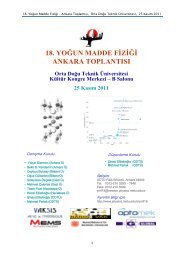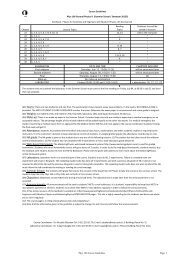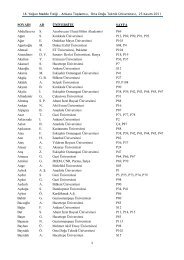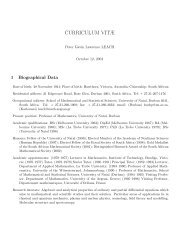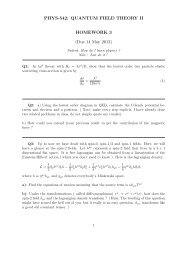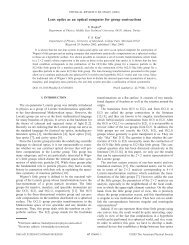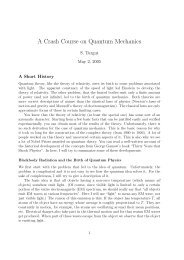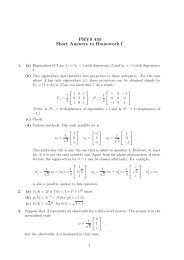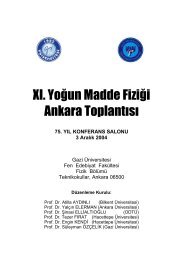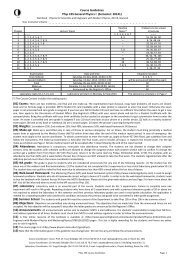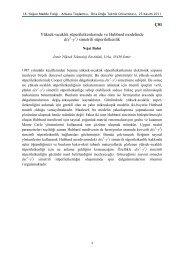SExtractor Draft - METU Astrophysics
SExtractor Draft - METU Astrophysics
SExtractor Draft - METU Astrophysics
- No tags were found...
You also want an ePaper? Increase the reach of your titles
YUMPU automatically turns print PDFs into web optimized ePapers that Google loves.
14Segmentation in <strong>SExtractor</strong> is achieved through a very simple thresholding process: a group ofconnected pixels that exceed some threshold above the background is identified as a detection.But things are a little bit more complicated in practice. First, on most astronomical images, thebackground is not constant over the frame, and its determination can be ambiguous in crowdedregions. Second, the software has to operate on noisy data, and some filtering adapted to thecharacteristics of the image has to be applied prior to detection, to reduce the contamination bynoise peaks. Third, many sources that overlap on the image are unlikely to be detected separatelywith a single detection threshold, and require a de-blending procedure, which is actually multithresholdingin <strong>SExtractor</strong>. Each of these points will now be described in greater detail below.It is worth mentioning here that these 3 difficulties could, to a large extent, be bypassed usinga wavelet decomposition (e.g. Bijaoui et al. 1998). Although such an algorithm might beimplemented in a future version of <strong>SExtractor</strong>, current constraints in processing speed, availablememory (processing of gigantic images) make the “pedestrian approach” still more interestingin the case of large scale surveys.6.1 Background estimationThe value measured at each pixel is a function of the sum of a “background” signal and lightcoming from the objects of interest. To be able to detect the faintest of these objects and alsoto measure accurately their fluxes, one needs to have an accurate estimate of the backgroundlevel in any place of the image, a “background map”. Strictly speaking, there should be onebackground map per object, that is, what would the image look like if that object was absent.But, at least for detection, we may start by assuming that most discrete sources do not overlaptoo severely, which is generally the case for high galactic latitude fields.To construct the background map, <strong>SExtractor</strong> makes a first pass through the pixel data, computingan estimator for the local background in each mesh of a grid that covers the whole frame.The background estimator is a combination of κ.σ clipping and mode estimation, similar to theone employed in Stetson’s DAOPHOT program (see e.g. Da Costa 1992). Briefly, the localbackground histogram is clipped iteratively until convergence at ±3σ around its median; if σis changed by less than 20% during that process, we consider that the field is not crowded andwe simply take the mean of the clipped histogram as a value for the background; otherwise weestimate the mode with:Mode = 2.5 × Median − 1.5 × Mean (1)This expression is different from the usual approximationMode = 3 × Median − 2 × Mean (2)(e.g. Kendall and Stuart 1977), but was found to be more accurate with our clipped distributions,from the simulations we made. Fig. 2 shows that the expression of the mode aboveis considerably less affected 6 by crowding than a simple clipped mean — like the one used inFOCAS (Jarvis and Tyson 1981) or by Infante (1987) — but is ≈ 30% noisier. For this reasonwe revert to the mean in non-crowded fields.Once the grid is set up, a median filter can be applied to suppress possible local overestimationsdue to bright stars. The resulting background map is then simply a (natural) bicubic-splineinterpolation between the meshes of the grid. In parallel with the making of the background map,an “RMS-background-map”, that is, a map of the background noise in the image is produced.It will be used if the WEIGHT TYPE parameter is set different from NONE (see §7.1).6 Obviously in some very unfavorable cases (like small meshes falling on bright stars), it leads to totallyinaccurate results.



